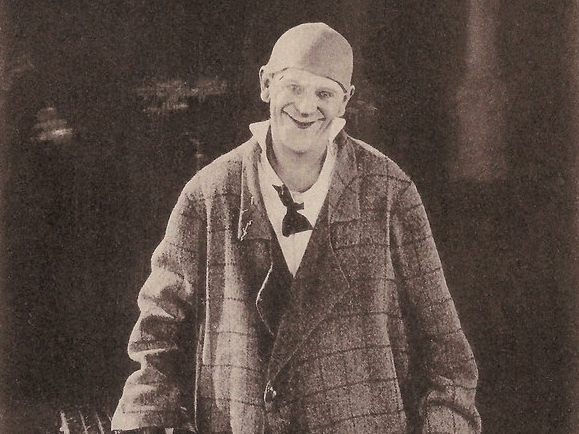European Slapstick – Prog. 5
Clowning Around (the World)
[CHARLIE RIVEL AS CHAPLIN] (??, 192?)
photog: ??. cast: Charlie Rivel. copia/copy: DCP, 1′; senza did./no intertitles.
One aspirant for the title of the 20th Century’s “King of the Circus Clowns” was Spanish Charlie Rivel. Born Josep Andreu i Lasserre in 1896, he began appearing on stage at the tender age of three. He soon graduated into the family’s clown group “The Rivels”, and at the height of the Chaplin craze in 1916 established his brilliant “Chaplin on the trapeze” act, leading to his stage name of Charlot (or Charlie) Rivel(s). A sensation of 1920s European circus, music hall, and variety, he even claimed to have won a Chaplin lookalike contest against the real Chaplin and had to weather a plagiarism lawsuit from United Artists. Very successful in the 1930s and 1940s in his own, genuine clown character attire, Rivel also played the Harry Langdon-esque silent lead in 1943’s Akrobat Schö-ö-ön! Rivel successfully continued his career after the war, became a mentor to Pierre Etaix, and performed until 1982. Moving images of Rivel’s Chaplin imitation seem to be extremely rare; this home movie from the 1920s offers what clearly appears to be fleeting glimpses of Rivel in his prime and in full tramp attire, apparently promoting a circus performance, quite possibly one in the Cirque d’Hiver, where an image of “Charlot” Rivel on the trapeze graces the walls to this day.
Ulrich Ruedel
SON PREMIER FILM (FR 1926)
regia/dir, scen: Jean Kemm. asst dir: Henriette Kemm. photog: Maurice Forster, Jean Jouannetaud. cast: Grock (Céleste Noménoé), Pierrette Lugand (bambina/the little girl), Gaston Dubosc (nonno/the grandfather), Roger Huguenet (bambino/the little boy), Valentine Lugand (Blanche), Simone Montalet (ragazza/the young woman), Lucien Baroux (regista/the director), Georges Cahuzac (direttore del music-hall/director of the music hall), Marguerite de Morlaye (nonna/the grandmother), Huguette Hefti (Jeannine), Emile Roques (socio del direttore/director’s associate), Lucien Callamand (commissario/police commissioner), Allary (assistente/assistant), Lequen (direttore di scena/stage manager), Toulet (ladro/the thief), Hasoutra (ballerina/dancer), Nico Romoff (ballerino/dancer), corps de ballet du Casino de Paris. prod: Jacques Haïk, Les Établissements Jacques Haïk. dist: Grands Spectacles Cinématographiques. uscita/rel: 10.12.1926. copia/copy: 35mm, 2267 m. [orig. 2400 m.], 99′ (20 fps); did./titles: FRA. fonte/source: CNC – Centre national du cinéma et de l’image animée, Bois d’Arcy. Restauro/Restored 2010. Diritti/Rights: FILMS REGENT ARCHIVES JACQUES HAÏK
With his bald head, baggy pants, and ridiculously tiny violin, Swiss-born Adrian Wettach effectively held the title of “The King of Clowns” for decades. The son of a watchmaker, Wettach was born in 1880 and was already performing as a tightrope walker by the age of fourteen. With some years of circus experience under his belt, Wettach partnered with eccentric clown Marius Galante of the “Brick and Brock” team in 1903. Galante was looking for a replacement for his former partner, and Wettach stepped in – creating the name of Grock. More experience came working with the Cirque de Paris’ white-face clown Antonet, and after 1915 Grock became a European comedy phenomenon. Headlining in Berlin and London as “The Famous French Clown,” in addition to playing at the Coliseum from 1915 to 1924, Grock’s clown make-up did without a traditional clown nose obstructing his expressive face, allowing every facial muscle to be seen. His stage routines effectively mixed visual comedy and acrobatics with his tremendous musical talent and multilingual non-sequitur verbal comedy. A number of his routines were released as 78 rpm recordings, and included trademark lines such as the German “Nit möööglich” [“Impossible”] or the equally protracted French “Pourquoi” [“What for?”].
Being one of the highest-paid entertainers in the world, it was inevitable that Grock would end up in silent films, but it came surprisingly late in the game. His debut came in the aptly-titled 1926 feature Son Premier Film, which follows the clown’s progress as a village eccentric who goes to the big city for an inheritance, and after misadventures with petty crooks and the police eventually finds stardom and love. Grock turns the standard plot on its head by being a very unconventional local boy making good, and the use of real streets and locations gives the film an off-the-cuff and idiosyncratic look.
Director Jean Kemm was a former actor. Among his other work was a collaboration with E.A. Dupont on the multi-language versions of Atlantic (1930), and he continued working until 1938.
Grock’s trademark phrase “Pourquoi” appears as his frequent title-card response in the film, and was used as an alternative French title for the picture. It was also translated into English as “What for?,” which became the name of the shortened UK version. The comedian’s later feature films are Grock (1931), which uses a domestic comedy plot as an excuse for an extended and priceless recording of his comedy routine (and was a dramatic financial loss for the comic), and Au revoir, Monsieur Grock (1950), essentially a flashback biopic.
Ulrich Ruedel, Steve Massa






